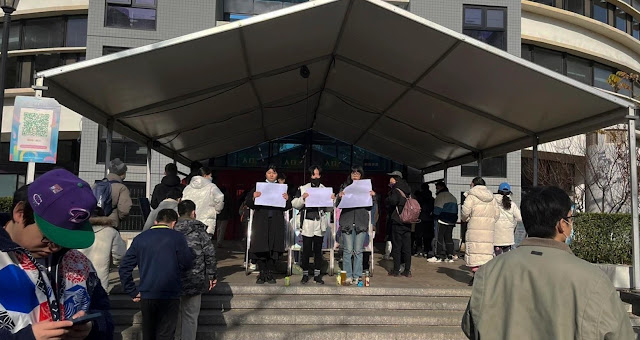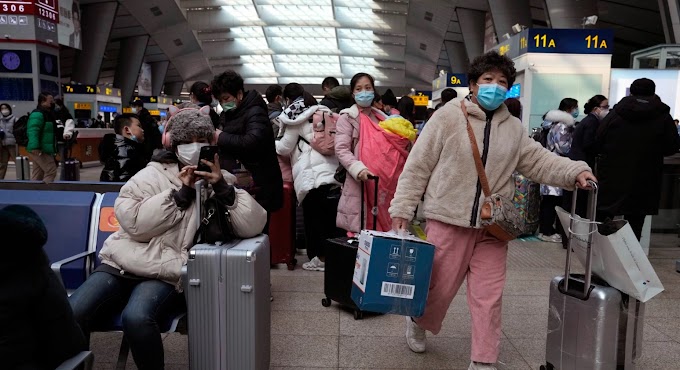Huangpu Jiangfeng The end of China's zero-zero policy-historical regression or social awakening?
Editor's note: This is an opinion piece written by Jiang Feng for Voice of America. This guest commentary does not reflect the views of Voice of America. Reprinters please indicate that they are from Voice of America or VOA.
Since the promulgation of the "Twenty Articles" on November 10, the social situation in China seems to have fallen into an unprecedented chaos. The situation is changing every day, as if entering a strange state of anarchy, just like the early days of the Cultural Revolution. situation. In particular, just a few days after the fire in Urumqi on November 24, fierce protests swept across the country, forming a self-rescue movement of the people on an unprecedented scale since 1949.
Moreover, this highly spontaneous struggle and rapid development of the situation cannot be mobilized by any organization or so-called external forces, and it is beyond the rigid understanding of traditional bureaucracy and media bureaucracy, and is heading towards a near-revolutionary direction. evolve. How to assess the development of this movement, whether it will catch up with the large-scale protests in Iran in the past few months, or recreate the 2011 Jasmine Revolution, or return to the traditional track of Chinese politics, such as the mass protests held by Hong Kong people in 2019. The demonstrations and subsequent brutal suppression, or earlier, going back to the 7,000-person meeting in 1962, awakening the error-correction mechanism within the CCP?
If we only look at it from the perspective of the policy of dynamic zeroing, this is the direction of public dissatisfaction and the main source of the current chaos. Just a week ago, before the opening of the World Cup in Qatar, China was still in chaos after the release of the "Twenty Points". On the one hand, it insists on dynamic clearing, while on the other hand it makes slight adjustments. The contradictory signals of "necessary and necessary" issued by the "Twenty Points" are like the revival of "grasping revolution and promoting production" in the late period of the Cultural Revolution. While the government and the people are at a loss, it also leads to the brewing of a political crisis.
Such a situation is not only like the end of 1961, when the "three-year famine" was coming to an end, but also like the beginning of the Cultural Revolution in 1966. In the six months after the "516" notice was released, Mao Zedong certainly gained unparalleled absolute authority, but the subversion of the bureaucratic system under the slogans of "kicking out the party committee for revolution" and "smashing the public prosecutor's law" also brought Chinese society into unprecedented chaos. . After the Shanghai "General Department of Industry" seized power, Zhou Enlai presided over a meeting of the Politburo and formulated the so-called "Six Public Security Articles" in accordance with Mao Zedong's "several articles" instruction. It was not officially abolished until 1979 in the form of a temporary criminal law throughout the Cultural Revolution. In contrast, the timing and purpose of the "Twenty Points" must be said to reflect, to some extent, China's current weird political situation of "kicking out the State Council to make zero efforts".
On November 10, the Politburo Standing Committee meeting chaired by Xi Jinping and composed of all favorites elected at the just-concluded 20th National Congress discussed and approved the so-called 20 Articles, and the next day the State Council, where the premier was absent, promulgated them. Although compared with the "Nine Prohibitions" promulgated by the State Council for a long time but difficult to implement, the 20 Articles have only been used and only made minor technical adjustments, but they have left local governments that have always adhered to zeroing as the only standard before. The transition zone between retreat and cover, persistence and lying down, zeroing out and coexistence is at a loss.
This, in fact, was also the situation before the 7,000-member meeting was held from the end of 1961 to the beginning of 1962. Also at the central meeting held on November 10, in the face of Deng Xiaoping’s 1962 annual grain requisition target, all secretaries of the Central Bureau fell silent. Mao Zedong was forced to retreat to the second line. Of course, this struggle eventually ignited the Cultural Revolution four years later.
For the new members of the Politburo Standing Committee who were born in the Red Guards, this period of history may be the most familiar, so it is called "hard exploration." On the contrary, for most Chinese people, either immersed in the afterglow of globalization or trapped in the torment of the epidemic, including those intellectuals who are obsessed with the suffering of the Cultural Revolution, they may have forgotten the aftermath of the Cultural Revolution after 1949. The most critical turning point before the outbreak was a brief but incomplete correction in the history of the CCP. When China's political system is going further and further down the road of restoration, the system and reality are repeating the disaster of the three-year famine from 1959 to 1961, and even the deterioration of Sino-US relations during the epidemic is similar to the 22 The openness of conflicts between the Soviet Union and China, and how to prevent the second meeting of 7,000 people after the end of the three-year epidemic may become the most worrying issues for the Chinese leadership before the 20th National Congress.
Sixty years ago, on the afternoon of January 27, 1962, at the beginning of the conference, Liu Shaoqi threw away his speech script and told the truth with what Bo Yibo later called "fearless courage", that is, he told the bad economic situation and the "Three Divide natural disasters into seven parts of man-made disasters", talk about "three to seven", openly deny Mao Zedong's famous "relationship between one finger and nine fingers", and made a "passionate, vivid and powerful" political mobilization for the party elite at that time , it is possible to lead the adjustment of the CCP’s policy after the meeting, and walk out of the wrong political line that led to the three-year famine.
Of course, this meeting of 7,000 people was unprecedented in the history of the CCP, but it did not completely win, which laid the groundwork for the ten-year civil turmoil of the Cultural Revolution. Later, only the Third Plenary Session of the Eleventh Central Committee at the end of 1978 could be regarded as partially inheriting the model of the 7,000-person conference, and truly completed the liquidation of ideas and routes, helping the century-old CCP to turn in time and return to the correct path welcomed by the people. Also because of the existence of this historical rationality, many old Chinese politicians, the bourgeoisie, the new middle class, and intellectuals who were beneficiaries of the reform and opening up, still had illusions until the 20th National Congress of the Communist Party of China, thinking that the error correction within the CCP The mechanism and power have not been lost, and it is still possible to stand up and turn things around at the last moment, or after the 20th National Congress or after the 20th National Congress.
Looking back now, this is of course an illusion, a very naive illusion, ignorant of the fundamental changes that have taken place in China's political ecology and institutions in the past ten years. An authoritarian secular party has approached A totalitarian system without any internal challenge.
Similarly, it now appears that the dramatic scene at the 20th Congress and the final all-in-one team are not only the inevitable result of this transformation, but also to prevent the emergence of the second or new 7,000-member congress, and to prevent any possibility within the party. The power of the Communist Party of China has used the review of the three-year epidemic situation as an excuse to promote a political turnaround. Perhaps this is the original intention of the Central Committee of the Communist Party of China repeatedly emphasizing "two establishments and two maintenances" around the 20th National Congress. It is a historical fear in the name of political security, and it is also a political fear.
In this sense, although China’s dynamic zero-clearing policy has gone bankrupt after the closure of Shanghai, and the public’s psychology has already entered the post-epidemic era, it is conceivable that there will be no new 7,000-person meeting in 2023, and The dynamic clearing policy will not automatically withdraw from the stage of history. Although the authorities may give up or change the specific measures of dynamic clearing, due to the closed-door mode of "foreign defense import, internal defense rebound", the authorities will regard the core of the system of dynamic clearing as an important legacy of the 20th National Congress of the Communist Party of China. perpetuate.
For the public, this kind of political expectation is hopeless, which may be the root cause of the wave of protests that have erupted across the country in the past few days. For the citizens of Shanghai, the grievances and anger accumulated in the first half of the closure of the city have not been vented, but the personnel layout of the 20th National Congress of the Communist Party of China has sealed the people's dissatisfaction like a seal. For the majority of young students, three years of campus control and online classes have long been enough, and they have been traumatized psychologically and cerebrally. For ordinary residents or the middle class in big cities, the arbitrary violence from grassroots control in the final stage of the three-year epidemic has seriously damaged their dignity. Amid the political chaos and despair following the "Twenty Articles," a great social awakening is taking shape.
Three weeks after the promulgation of the "Twenty Articles", Chinese society reached a critical point. It was at this critical point that a fire in Urumqi awakened the historical relationship between Xinjiang and Shanghai, the concentration camps in Xinjiang and the shelters in various places, Foxconn's workers and the campus, and so on. The next action: demand to unblock, walk out of the community, tear down the fence, mourn the dead, and it spread like a fire. A national protest movement unprecedented since 1949 has emerged.








